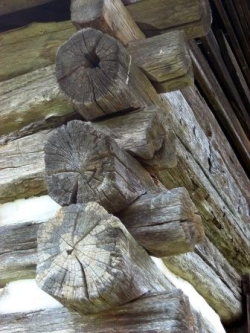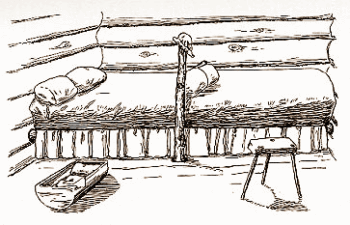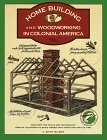-
History of:
- Resources about:
- More:
- Baby walkers
- Bakehouses
- Bed warmers
- Beer, ale mullers
- Besoms, broom-making
- Box, cabinet, and press beds
- Butter crocks, coolers
- Candle snuffers, tallow
- Clothes horses, airers
- Cooking on a peat fire
- Drying grounds
- Enamel cookware
- Fireplaces
- Irons for frills & ruffles
- Knitting sheaths, belts
- Laundry starch
- Log cabin beds
- Lye and chamber-lye
- Mangles
- Marseilles quilts
- Medieval beds
- Rag rugs
- Rushlights, dips & nips
- Straw mattresses
- Sugar cutters - nips & tongs
- Tablecloths
- Tinderboxes
- Washing bats and beetles
- Washing dollies
- List of all articles
Subscribe to RSS feed or get email updates.
Illinois, c1810:
All or nearly all, of the pioneer log cabins were finished with a one leg bedstead. To start with you must have an unplastered log house, then a post and two bedrails. Each rail is fastened in an auger hole in the wall. The sides of the house wall formed the end of the bed, and thus a one legged bedstead is complete. Cross pieces are laid across the bedrails. The bedtick is filled with leaves or grass and the bed is finished.
Crawford County memoirs
Homebuilding and Woodworking in Colonial America
Alabama, c1820:
..."Alabama Bedsteads", pallets of broom sage, crabgrass, or corn shucks put atop rough frames fitted into cracks in two walls and supported by a single corner pole.
Virginia Van Der Veer Hamilton, Alabama: A History, 1984
Log cabin beds with one leg
Jack bed, one-legged bedstead, Alabama bed
 Imagine
a pioneer family, ready to settle in a new part of America, building a small log
cabin. They have brought no furniture with them, and need a quick, simple way of
making a bed-frame. They can fix two sides of the bed to two adjacent walls. Two
poles will be the other two sides: each with one end fitted into a wall, and the
other end attached to one single bedpost, the only bed-leg. Then you have a one-legged
bed neatly tucked into one corner of the small home. Often they're called one-legged
bedsteads or one-leg beds, and in Alabama, an Alabama bedstead.
Sometimes they were called jack beds, which usually suggests a highish
bed with room for a smaller trundle or truckle bed underneath.
Imagine
a pioneer family, ready to settle in a new part of America, building a small log
cabin. They have brought no furniture with them, and need a quick, simple way of
making a bed-frame. They can fix two sides of the bed to two adjacent walls. Two
poles will be the other two sides: each with one end fitted into a wall, and the
other end attached to one single bedpost, the only bed-leg. Then you have a one-legged
bed neatly tucked into one corner of the small home. Often they're called one-legged
bedsteads or one-leg beds, and in Alabama, an Alabama bedstead.
Sometimes they were called jack beds, which usually suggests a highish
bed with room for a smaller trundle or truckle bed underneath.
Most of these beds are gone and pictures of them are hard to come by. Reading about one-legged bedsteads suggests most were supported by a floor-to-ceiling bedpost at one corner. The picture below is of a less common design where two beds fit in between three walls of the cabin, and the post helps to support both.
The wood used as the "leg" could be only just higher than the bed or it could stretch to the roof. There were different ways of fitting the logs or poles into the wall, and then various possible ways of fixing slats or branches or strips of bark or hide across the side-rails to support skins, or a tick, a simple mattress, once the family had made one. The tick was a cloth sack, and it was filled with corn shucks, or straw, or other suitable plant material. Often the bed was high enough for the family to keep a trundle bed underneath: one that you could slide out at bedtime for the children. As furnishings were added and the cabin decorated, a cotton valance might be pinned round the sides of the bed, and/or storage built beneath.
 With
pictures in short supply, we'll rely on descriptions, mostly from people who
saw or slept in such beds. First is Sarah Brewer-Bonebright, born in 1837, talking
about mid-19th century Iowa.
With
pictures in short supply, we'll rely on descriptions, mostly from people who
saw or slept in such beds. First is Sarah Brewer-Bonebright, born in 1837, talking
about mid-19th century Iowa.
The pioneer wall-bedstead had but one leg; and it was put in place by the regular cabin builders. Very often two beds had but one leg-if the width of the cabin was twelve feet. I have seen two beds and several wall-bunks resting on one strong sapling leg-support. One end of the pole foot-rail and, likewise, an end of the side-rail was fastened to the single bed-leg, and the other ends were fitted into an auger-hole in the log wall....
It often happened, when the burden was too heavy, the slats settled and slipped from the wall cracks and precipitated the occupants of the bed to the floor. If cord were used instead of slats, saplings were fastened to the wall and the rope cris-crossed from them according to the usual method. Sometimes a linen blanket or quilt was fastened to the logs and to the side-rail and bed end. This did away with the slipping slats, but the sag to the center was much greater than with the cord-woven support.
Harriet Bonebright-Closz, Founding of Newcastle now Webster City, Iowa, 1921
The drawing comes from the same book on Iowa as the excerpt above. Next is a writer who saw 20th century jack beds in the "southern Appalachian highlands", and wondered if something similar had been used by the very earliest settlers in North America .
Just what [the earliest American settlers'] beds were like cannot be stated with any certainty, as none of them have survived. There is a form used by the mountaineers in the southern Appalachian highlands that doubtless approximates our first type of frame. They call it a jack bed and it consists of a single post set about six feet from one wall and four feet from another. From it, side rails extend to the two walls, and others are attached to them to provide the necessary support for slats or springy poles on which is laid the tick filled with straw, reeds, or fine-cut rags, as the case may be....
Thomas Hamilton Ormsbee, The Story of American Furniture, 1941
A description of early cabin bedsteads in Kentucky, written more than a century after the period it discusses:
A single fork, placed with its lower end in a hole in the floor, and the upper end fastened to a joist, served for a bedstead, by placing a pole in the fork with one end through a crack between the logs of the wall. This front pole was crossed by a shorter one within the fork, with its outer end through another crack. From the front pole, through a crack between the logs of the end of the house, the boards were put on which formed the bottom of the bed.
Cecil B. Hartley, Life and Times of Colonel Daniel Boone, c1902
 13 March 2008
13 March 2008
You may like our new sister site Home Things Past where you'll find articles about antiques, vintage kitchen stuff, crafts, and other things to do with home life in the past. There's space for comments and discussion too. Please do take a look and add your thoughts. (Comments don't appear instantly.)
For sources please refer to the books page, and/or the excerpts quoted on the pages of this website, and note that many links lead to museum sites. Feel free to ask if you're looking for a specific reference - feedback is always welcome anyway. Unfortunately, it's not possible to help you with queries about prices or valuation.



